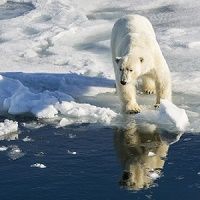Plan Ahead: Watch Polar Bears in Canada in October
Seeing polar bears in northern Canada is a once-in-a-lifetime opportunity. Book your fall trip now.

Dancer jumps up, pressing his long black nose against the glass window that separates us so that we’re eyeball to eyeball. His luminous brown eyes look kind and curious as he raises his snout ever so slightly back and forth—the better to sniff us.
Although Dancer’s playful as a puppy, he’s no house dog. Instead, he’s a 1,300-pound, 10-foot-tall polar bear, North America’s largest carnivore, and he’s on the prowl in the Canadian subarctic. Dancer, along with about 1,200 white giants, roams the frozen terrain of Churchill, Manitoba, Canada, from mid-September to early November. They gather along the west shore of Hudson Bay, waiting for the water to freeze into thick ice blocks. The bears use these as platforms from which to hunt for seals. When the bay turns nearly solid, the bears depart.
But not quite yet. Although an air of anticipation fills Dancer’s daylight prowls, tonight the big bear prances. Dancer, standing on his hind legs, executes the two-legged hop for which he was named. Upright, Dancer peers at us through the window. With his huge front paws he rocks the massive tundra buggy we’re in as if it’s as light as a baby’s cradle. Dancer likes the engineer.
In this untamed territory, polar bears surround us. For three days in October we live in a train-like chain of tundra buggies constructed from reconditioned, extra wide tractor bodies. The Tundra Buggy Lodge features a lounge, a dining car and sleeping cars with upper and lower berths that look like large shelves and shared bathrooms. Snores, sighs, and coughs of our fellow explorers roll through the halls.
Nonetheless, the inconvenience is worth it. Through the windows when we’re dining, we often see a bear snoozing, nestled against the snowdrifts, or another rolling on his back, juggling a frozen ball of kelp with the finesse of a pro basketball player.
Each morning after breakfast, we board a moveable buggy to roll through the landscape in search of critters. When the bears amble towards us, we stand outside on our vehicle’s viewing platform to get close to these majestic creatures. Some press their huge paws against our tundra buggy’s sides. We’re so near to these giants that we can see their breath turn to silky frost. Up close the bears, with their round bellies, purple tongues, and pigeon-toed gaits, remind us more of overgrown stuffed toys than vicious predators.
One night a blizzard engulfs us. Roaring gales of nearly 70 miles per hour violently shake the vehicle, making it difficult to sleep. The next night, however, the sky turns so clear that the northern lights, the Aurora Borealis, glow like godly fireworks. Undulating ribbons of green and white dance across the heavens, alternating with thick swaths of neon blue splashed against the inky black sky. We feel blessed just to be here.
Frontiers North operates multi-day as well as daytrips into the Churchill Wildlife Management area.
What arctic wildlife do you most wish to see? Connect with me on Twitter, @familyitrips.
ACTIVA BioACTIVE Bulk Flow Marks Pulpdent’s First Major Product Release in 4 Years
December 12th 2024Next-generation bulk-fill dental restorative raises the standard of care for bulk-fill procedures by providing natural remineralization support, while also overcoming current bulk-fill limitations.